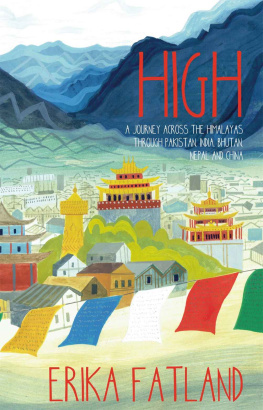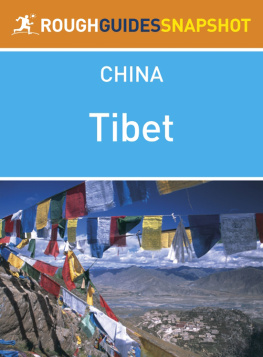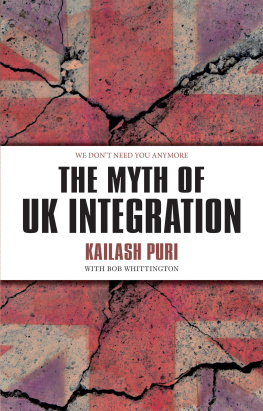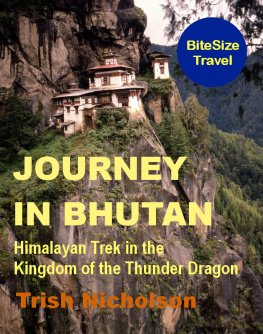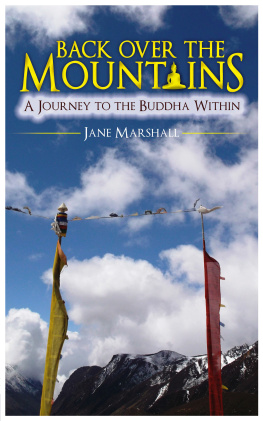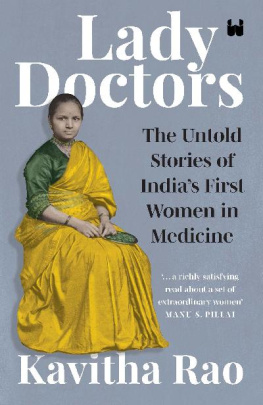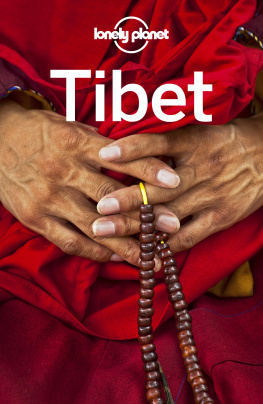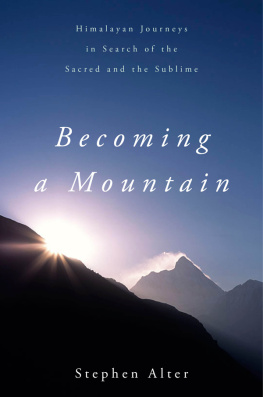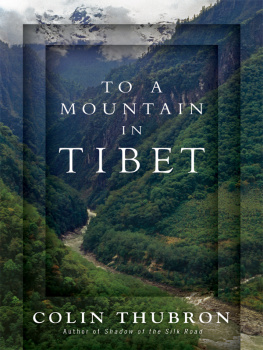Table of Contents
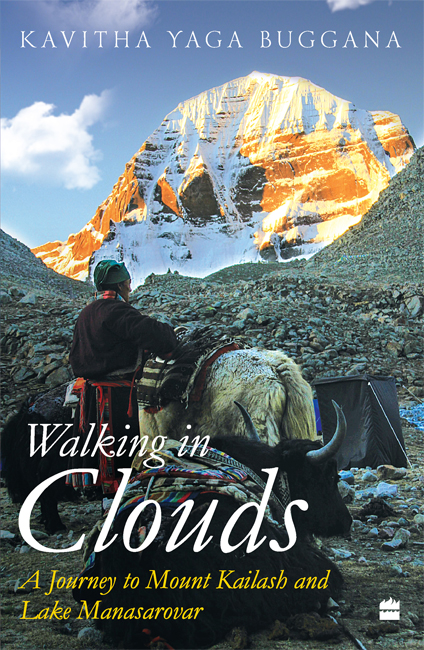
Walking in Clouds
A Journey to Mount Kailash and Lake Manasarovar
KAVITHA YAGA BUGGANA

To my father-in-law,
who loved books and who would have been delighted
to read this one.
And to my parents,
who raised me with the confidence that a womans place is in her home, her office, her studio, her lab, and wherever else her
dreams may take her.
Contents


THERE ARE A LAKE and a mountain at the roof of the world where the air is thin and the clouds linger on cliffsides. These are places of wonder and the journey to see them will take many days. My cousin, Pallu, and I do not know if we will make it to these places or what drives us to go, but this is a journey we promised ourselves decades ago when we were still schoolgirls.
In those days we would climb the small, rounded hills that surrounded our school, nestled in a valley. It would take us an hour or two to reach the large rocks near the top. There, we stretched out on boulders as the clouds thinned slowly in the heat. We dreamed of adventures that seemed to lie waiting, just outside our sleepy world. And the greatest of all adventures was a journey to that lake and the mountain that were so far away so beautiful that they seemed to belong more to the sky than to the earth.
Nepalgunj, Nepal
Altitude ~ 150 metres

ON THIS CLEAR MORNING in September, the sun shimmers and heat weaves itself into the dry earth. Its been four days since Pallu and I left our homes in Hyderabad, but our trek has not yet begun. Perched on a ledge outside the Nepalgunj airport building, my cousin and I wait with the others. Ying has, for the moment, put away her enormous black camera. She carries it everywhere despite her bad leg that drags. Sperello chats with Prarthana, Pallus friend from home. Jeff, in his green Buddha T-shirt and wavy blonde hair, darts around the tiny airport lawn chasing a lizard. The scraggy grass and the leaves of the trees are lined with dust.
So, do you think we will make it to Simikot today? I ask Katy, who has found a shaded spot near the garden.
As an icebreaker, it will have to do. Pallu, Prarthana, and I had travelled together from Hyderabad, but we met the others only last night at Kathmandu airport.
I think so, Katy says. Her smile is quick, but warms her face all the way to her eyes.
I hear theres a group thats been stranded here for two days, waiting to get to Simikot, Pallu adds.
Everyone at this airport is waiting to fly to the tiny mountain town of Simikot. The length of our wait depends on Simikots unreliable weather. Simikot is the starting point of the trek through Humla in northwest Nepal. The Humla trek forms the first leg of our journey to Mount Kailash and Lake Manasarovar in Tibet.
Katy is a Hong Kong Chinese who moved to Vancouver years ago. She tells us she leads a busy life. A trained nurse, she is a hospital administrator and an avid trekker, with a grown-up daughter whose life is even busier than hers.
How old are your kids? Katy asks.
My daughter is fourteen and my son is eight, Pallu replies.
Enjoy them. The best time is when they are little, Katy says, her voice wistful.
My boys are fourteen and eleven. I picture my older son playing street cricket and my younger one sifting through a sea of Lego pieces, looking for the right one.
Memories of home on the morning of the journey well up: the garden, dark green with grass and dew, and its corner of pink oleander and red hibiscus; the children, their heads still droopy with sleep; Hari, my husband, quiet, as he sips coffee from his white porcelain cup. Though he tries not to show it, he is worried. He cannot understand why I am going to these places beyond the edges of our world. What drives me? How can I leave everyone for so long? What will happen to the family if something happens to me? These are fair questions. I am not sure I have the answers.
At Nepalgunj airport the sun grows stronger. Finally, our guide, Chhiring, a slightly built, wiry man in his twenties, shepherds us into the airport lounge. A Nepali serial plays on the television mounted on a wall. It reminds me of the Hindi television serials from the 1980s, screened by Indias state-owned channel, Doordarshan. This is how all of Nepal feels to me. Its chaotic, honking cars veering around gigantic potholes, its demure women in bright saris and sindoor, the lingering innocence of its people call to mind the India of decades ago. After a while, the anachronistic novelty of the Nepali serial wears off and the tedium of waiting the untold story of all travel sets in.
I hear gasps and laughter. The airport security guards two children squeal with delight as Jeff performs magic tricks. He makes grand gestures with his hands and brandishes a card in the air. The boy claps his hand over his lips. The girls eyes widen and her shoulders scrunch in glee. Ying and Sperello take pictures. Pallu comes over to watch, and when the children laugh, we laugh with them.
After noon, when the winds in Simikot have turned heavy, Chhiring tells us it is unsafe to fly today. We head back to the hotel where Pallu, Prarthana, and I sink into our air-conditioned rooms. The ebullient Prarthana is strangely quiet.
How are the kids? Pallu asks Prarthana. Their sons are classmates and their daughters are friends.
They can watch too much TV, they can eat what they want why wont they be fine? Prarthana says.
Pallu laughs.
We will be gone a long time, but they will be fine, Prarthana adds, but I can see that she is less certain than she sounds. While Pallu and I have planned this journey for decades, Prarthana signed up just before registrations closed. Perhaps the implications of this long journey to the remotest of lands and the many days of being away from her family are only now dawning on her.
In the meantime, the foreigners (we call them that, though we all are foreigners in Nepal; they call us The Indian Ladies) are undismayed. They set out with cameras and sunhats to go sightseeing in rickshaws. They take pictures of old switchboards with bulbous switches and wires jutting out, fruit vendors, old rickshaws, dirty chicken stores, and stray donkeys. In our Indian towns, these sights are the embarrassing details of the grimy and run-down country we are trying to outgrow. But in their eyes, the falling-apart switchboard is a marvel of ingenious work-arounds; the fruit shop, with its piles of bright red, earthy brown, and bold yellow fruits, arranged in colour-coded geometry, an artists delight.
In the evening, we gather at the hotels restaurant. The rectangular structure with over-lit interiors is, I learn, an Indian restaurant. I dont know why I am surprised since the Indian border is only a few minutes drive away, but my heart sinks. Most small Indian restaurants serve over-spiced, oil-drenched, clichd imitations of the real thing. I say nothing, as the foreigners seem excited. I dont tell them that there is no such thing as Indian food. There is no such thing as Telugu food, even, or Tamil food. Each district has its microcosm of culinary traditions that use local ingredients for preparations, and they depend on the seasons, temperatures, and principles of Ayurveda. Therefore, even narrow geographic areas encompass a dizzying diversity of cuisine. My mothers village, for example, is famed for its tangy, spicy tamarind curries eaten with rice, while in my fathers village they make steaming hot balls of ragi millets. In my husbands village, a meal without pappu (zesty vegetable dals) and soft jonna rotis is not a meal at all. And these villages are all within a few hours drive of each other. In this over-bright restaurant in Nepalgunj, I run a sceptical eye over the ersatz Indian food on the menu.


